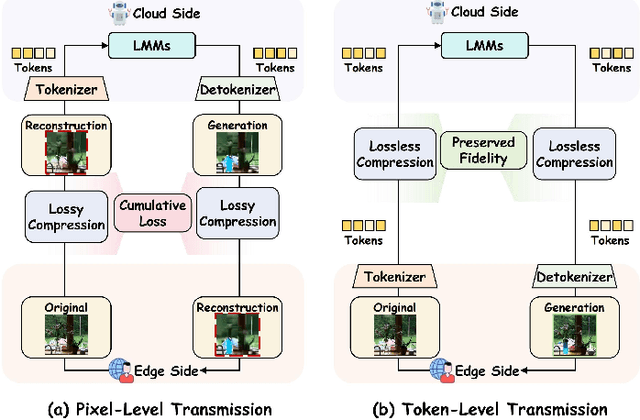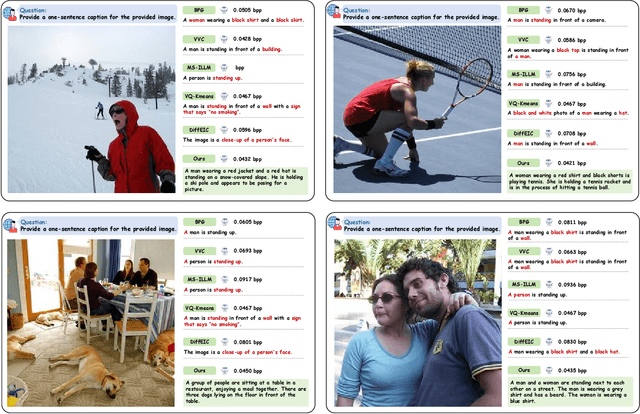Image Inpainting
Image inpainting is a task of reconstructing missing regions in an image. It is an important problem in computer vision and an essential functionality in many imaging and graphics applications, e.g., object removal, image restoration, manipulation, re-targeting, compositing, and image-based rendering.
Papers and Code
Security Risk of Misalignment between Text and Image in Multi-modal Model
Oct 30, 2025Despite the notable advancements and versatility of multi-modal diffusion models, such as text-to-image models, their susceptibility to adversarial inputs remains underexplored. Contrary to expectations, our investigations reveal that the alignment between textual and Image modalities in existing diffusion models is inadequate. This misalignment presents significant risks, especially in the generation of inappropriate or Not-Safe-For-Work (NSFW) content. To this end, we propose a novel attack called Prompt-Restricted Multi-modal Attack (PReMA) to manipulate the generated content by modifying the input image in conjunction with any specified prompt, without altering the prompt itself. PReMA is the first attack that manipulates model outputs by solely creating adversarial images, distinguishing itself from prior methods that primarily generate adversarial prompts to produce NSFW content. Consequently, PReMA poses a novel threat to the integrity of multi-modal diffusion models, particularly in image-editing applications that operate with fixed prompts. Comprehensive evaluations conducted on image inpainting and style transfer tasks across various models confirm the potent efficacy of PReMA.
UniAIDet: A Unified and Universal Benchmark for AI-Generated Image Content Detection and Localization
Oct 27, 2025With the rapid proliferation of image generative models, the authenticity of digital images has become a significant concern. While existing studies have proposed various methods for detecting AI-generated content, current benchmarks are limited in their coverage of diverse generative models and image categories, often overlooking end-to-end image editing and artistic images. To address these limitations, we introduce UniAIDet, a unified and comprehensive benchmark that includes both photographic and artistic images. UniAIDet covers a wide range of generative models, including text-to-image, image-to-image, image inpainting, image editing, and deepfake models. Using UniAIDet, we conduct a comprehensive evaluation of various detection methods and answer three key research questions regarding generalization capability and the relation between detection and localization. Our benchmark and analysis provide a robust foundation for future research.
SEE4D: Pose-Free 4D Generation via Auto-Regressive Video Inpainting
Oct 30, 2025Immersive applications call for synthesizing spatiotemporal 4D content from casual videos without costly 3D supervision. Existing video-to-4D methods typically rely on manually annotated camera poses, which are labor-intensive and brittle for in-the-wild footage. Recent warp-then-inpaint approaches mitigate the need for pose labels by warping input frames along a novel camera trajectory and using an inpainting model to fill missing regions, thereby depicting the 4D scene from diverse viewpoints. However, this trajectory-to-trajectory formulation often entangles camera motion with scene dynamics and complicates both modeling and inference. We introduce SEE4D, a pose-free, trajectory-to-camera framework that replaces explicit trajectory prediction with rendering to a bank of fixed virtual cameras, thereby separating camera control from scene modeling. A view-conditional video inpainting model is trained to learn a robust geometry prior by denoising realistically synthesized warped images and to inpaint occluded or missing regions across virtual viewpoints, eliminating the need for explicit 3D annotations. Building on this inpainting core, we design a spatiotemporal autoregressive inference pipeline that traverses virtual-camera splines and extends videos with overlapping windows, enabling coherent generation at bounded per-step complexity. We validate See4D on cross-view video generation and sparse reconstruction benchmarks. Across quantitative metrics and qualitative assessments, our method achieves superior generalization and improved performance relative to pose- or trajectory-conditioned baselines, advancing practical 4D world modeling from casual videos.
VidSplice: Towards Coherent Video Inpainting via Explicit Spaced Frame Guidance
Oct 24, 2025Recent video inpainting methods often employ image-to-video (I2V) priors to model temporal consistency across masked frames. While effective in moderate cases, these methods struggle under severe content degradation and tend to overlook spatiotemporal stability, resulting in insufficient control over the latter parts of the video. To address these limitations, we decouple video inpainting into two sub-tasks: multi-frame consistent image inpainting and masked area motion propagation. We propose VidSplice, a novel framework that introduces spaced-frame priors to guide the inpainting process with spatiotemporal cues. To enhance spatial coherence, we design a CoSpliced Module to perform first-frame propagation strategy that diffuses the initial frame content into subsequent reference frames through a splicing mechanism. Additionally, we introduce a delicate context controller module that encodes coherent priors after frame duplication and injects the spliced video into the I2V generative backbone, effectively constraining content distortion during generation. Extensive evaluations demonstrate that VidSplice achieves competitive performance across diverse video inpainting scenarios. Moreover, its design significantly improves both foreground alignment and motion stability, outperforming existing approaches.
Spatial-SSRL: Enhancing Spatial Understanding via Self-Supervised Reinforcement Learning
Oct 31, 2025Spatial understanding remains a weakness of Large Vision-Language Models (LVLMs). Existing supervised fine-tuning (SFT) and recent reinforcement learning with verifiable rewards (RLVR) pipelines depend on costly supervision, specialized tools, or constrained environments that limit scale. We introduce Spatial-SSRL, a self-supervised RL paradigm that derives verifiable signals directly from ordinary RGB or RGB-D images. Spatial-SSRL automatically formulates five pretext tasks that capture 2D and 3D spatial structure: shuffled patch reordering, flipped patch recognition, cropped patch inpainting, regional depth ordering, and relative 3D position prediction. These tasks provide ground-truth answers that are easy to verify and require no human or LVLM annotation. Training on our tasks substantially improves spatial reasoning while preserving general visual capabilities. On seven spatial understanding benchmarks in both image and video settings, Spatial-SSRL delivers average accuracy gains of 4.63% (3B) and 3.89% (7B) over the Qwen2.5-VL baselines. Our results show that simple, intrinsic supervision enables RLVR at scale and provides a practical route to stronger spatial intelligence in LVLMs.
TerraCodec: Compressing Earth Observations
Oct 14, 2025



Earth observation (EO) satellites produce massive streams of multispectral image time series, posing pressing challenges for storage and transmission. Yet, learned EO compression remains fragmented, lacking publicly available pretrained models and misaligned with advances in compression for natural imagery. Image codecs overlook temporal redundancy, while video codecs rely on motion priors that fail to capture the radiometric evolution of largely static scenes. We introduce TerraCodec (TEC), a family of learned codecs tailored to EO. TEC includes efficient image-based variants adapted to multispectral inputs, as well as a Temporal Transformer model (TEC-TT) that leverages dependencies across time. To overcome the fixed-rate setting of today's neural codecs, we present Latent Repacking, a novel method for training flexible-rate transformer models that operate on varying rate-distortion settings. Trained on Sentinel-2 data, TerraCodec outperforms classical codecs, achieving 3-10x stronger compression at equivalent image quality. Beyond compression, TEC-TT enables zero-shot cloud inpainting, surpassing state-of-the-art methods on the AllClear benchmark. Our results establish bespoke, learned compression algorithms as a promising direction for Earth observation. Code and model weights will be released under a permissive license.
SAGE: Scene Graph-Aware Guidance and Execution for Long-Horizon Manipulation Tasks
Sep 26, 2025Successfully solving long-horizon manipulation tasks remains a fundamental challenge. These tasks involve extended action sequences and complex object interactions, presenting a critical gap between high-level symbolic planning and low-level continuous control. To bridge this gap, two essential capabilities are required: robust long-horizon task planning and effective goal-conditioned manipulation. Existing task planning methods, including traditional and LLM-based approaches, often exhibit limited generalization or sparse semantic reasoning. Meanwhile, image-conditioned control methods struggle to adapt to unseen tasks. To tackle these problems, we propose SAGE, a novel framework for Scene Graph-Aware Guidance and Execution in Long-Horizon Manipulation Tasks. SAGE utilizes semantic scene graphs as a structural representation for scene states. A structural scene graph enables bridging task-level semantic reasoning and pixel-level visuo-motor control. This also facilitates the controllable synthesis of accurate, novel sub-goal images. SAGE consists of two key components: (1) a scene graph-based task planner that uses VLMs and LLMs to parse the environment and reason about physically-grounded scene state transition sequences, and (2) a decoupled structural image editing pipeline that controllably converts each target sub-goal graph into a corresponding image through image inpainting and composition. Extensive experiments have demonstrated that SAGE achieves state-of-the-art performance on distinct long-horizon tasks.
RePainter: Empowering E-commerce Object Removal via Spatial-matting Reinforcement Learning
Oct 09, 2025In web data, product images are central to boosting user engagement and advertising efficacy on e-commerce platforms, yet the intrusive elements such as watermarks and promotional text remain major obstacles to delivering clear and appealing product visuals. Although diffusion-based inpainting methods have advanced, they still face challenges in commercial settings due to unreliable object removal and limited domain-specific adaptation. To tackle these challenges, we propose Repainter, a reinforcement learning framework that integrates spatial-matting trajectory refinement with Group Relative Policy Optimization (GRPO). Our approach modulates attention mechanisms to emphasize background context, generating higher-reward samples and reducing unwanted object insertion. We also introduce a composite reward mechanism that balances global, local, and semantic constraints, effectively reducing visual artifacts and reward hacking. Additionally, we contribute EcomPaint-100K, a high-quality, large-scale e-commerce inpainting dataset, and a standardized benchmark EcomPaint-Bench for fair evaluation. Extensive experiments demonstrate that Repainter significantly outperforms state-of-the-art methods, especially in challenging scenes with intricate compositions. We will release our code and weights upon acceptance.
End4: End-to-end Denoising Diffusion for Diffusion-Based Inpainting Detection
Sep 16, 2025The powerful generative capabilities of diffusion models have significantly advanced the field of image synthesis, enhancing both full image generation and inpainting-based image editing. Despite their remarkable advancements, diffusion models also raise concerns about potential misuse for malicious purposes. However, existing approaches struggle to identify images generated by diffusion-based inpainting models, even when similar inpainted images are included in their training data. To address this challenge, we propose a novel detection method based on End-to-end denoising diffusion (End4). Specifically, End4 designs a denoising reconstruction model to improve the alignment degree between the latent spaces of the reconstruction and detection processes, thus reconstructing features that are more conducive to detection. Meanwhile, it leverages a Scale-aware Pyramid-like Fusion Module (SPFM) that refines local image features under the guidance of attention pyramid layers at different scales, enhancing feature discriminability. Additionally, to evaluate detection performance on inpainted images, we establish a comprehensive benchmark comprising images generated from five distinct masked regions. Extensive experiments demonstrate that our End4 effectively generalizes to unseen masking patterns and remains robust under various perturbations. Our code and dataset will be released soon.
UniMIC: Token-Based Multimodal Interactive Coding for Human-AI Collaboration
Sep 26, 2025



The rapid progress of Large Multimodal Models (LMMs) and cloud-based AI agents is transforming human-AI collaboration into bidirectional, multimodal interaction. However, existing codecs remain optimized for unimodal, one-way communication, resulting in repeated degradation under conventional compress-transmit-reconstruct pipelines. To address this limitation, we propose UniMIC, a Unified token-based Multimodal Interactive Coding framework that bridges edge devices and cloud AI agents. Instead of transmitting raw pixels or plain text, UniMIC employs compact tokenized representations as the communication medium, enabling efficient low-bitrate transmission while maintaining compatibility with LMMs. To further enhance compression, lightweight Transformer-based entropy models with scenario-specific designs-generic, masked, and text-conditioned-effectively minimize inter-token redundancy. Extensive experiments on text-to-image generation, text-guided inpainting, outpainting, and visual question answering show that UniMIC achieves substantial bitrate savings and remains robust even at ultra-low bitrates (<0.05bpp), without compromising downstream task performance. These results establish UniMIC as a practical and forward-looking paradigm for next-generation multimodal interactive communication.
 Add to Chrome
Add to Chrome Add to Firefox
Add to Firefox Add to Edge
Add to Edge